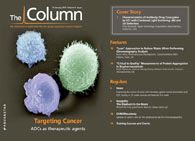Bugs boost wine aroma
A new strain of the enzyme ß-glucosidase isolated from the microbial strain Aureobasidium pullulans (Sp? ß-gl) improves the aroma of wine, according to a team of Brazilian researchers.1
A new strain of the enzyme ß-glucosidase isolated from the microbial strain Aureobasidium pullulans (Sp– ß-gl) improves the aroma of wine, according to a team of Brazilian researchers.1 Published in Appl. Biochem Biotechnol., the study indicated that the Sp– ß-gl strain functioned over a wide range of pH levels, had two peaks of optimum temperature and was tolerant to ethanol.
The aroma of wine is made up of volatile organic compounds (VOCs) and enzymatic treatment can release VOCs bound to sugars in wine to increase the aroma. One key class of flavouring compounds, glycosides, specifically terpenes (linalool, geraniol and nerol), are bound to sugar within the wine. Hydrolysis by enzyme treatment can free the sugar, releasing free terpenols. A significant increase of the level of free terpenols (linalool, geraniol and nerol) was identified using gas chromatography–mass spectrometry (GC–MS), validating the use of Sp– ß-gl in the improvement of wine aroma.
Scientists and winemakers have studied the microbial ecosystem within wine for some time. Societies of microbes exist within wine, and the relationships between different strains can be studied within this medium. These relationships are important to winemakers because they can change the composition and taste.
Traditionally, ß-glucosidase derived from fungus was used to improve aroma, however, this can result in the hydrolysis of anthocyanins producing aglycones, which are potentially toxic. Therefore, new strains of microbial enzymes for wine production are always in demand.
Reference
1. M. Baffi, T. Tobal, J. Lago, M. Boscolo, E. Gomes and Roberto Da-Silva, Appl Biochem Biotechnol, DOI: 10.1007/S12010-012-9991-2 (2012).

Best of the Week: Food Analysis, Chemical Migration in Plastic Bottles, STEM Researcher of the Year
December 20th 2024Top articles published this week include the launch of our “From Lab to Table” content series, a Q&A interview about using liquid chromatography–high-resolution mass spectrometry (LC–HRMS) to assess chemical hazards in plastic bottles, and a piece recognizing Brett Paull for being named Tasmanian STEM Researcher of the Year.
Using LC-MS/MS to Measure Testosterone in Dried Blood Spots
December 19th 2024Testosterone measurements are typically performed using serum or plasma, but this presents several logistical challenges, especially for sample collection, storage, and transport. In a recently published article, Yehudah Gruenstein of the University of Miami explored key insights gained from dried blood spot assay validation for testosterone measurement.
Determination of Pharmaceuticals by Capillary HPLC-MS/MS (Dec 2024)
December 19th 2024This application note demonstrates the use of a compact portable capillary liquid chromatograph, the Axcend Focus LC, coupled to an Agilent Ultivo triple quadrupole mass spectrometer for quantitative analysis of pharmaceutical drugs in model aqueous samples.